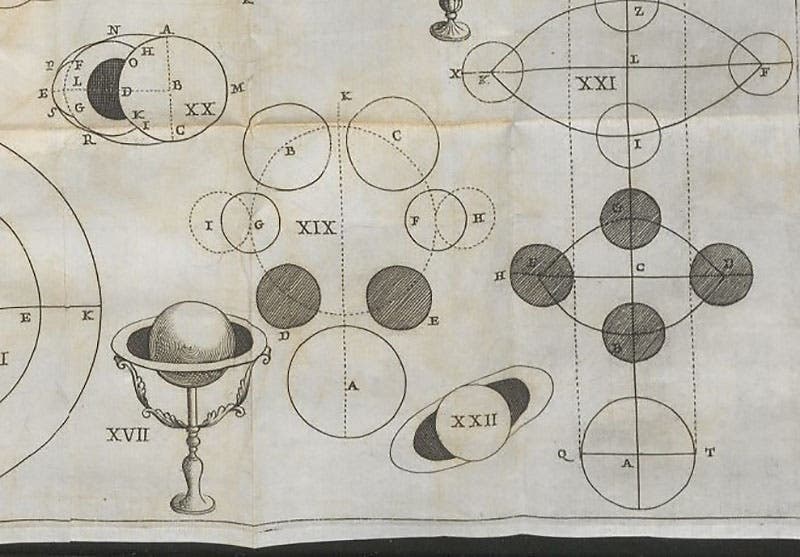Scientist of the Day - Honoré Fabri
Honoré Fabri, a French Jesuit physicist living in Rome, died Mar. 8, 1688, at the age of about 80. In 1659, the Dutch scientist Christiaan Huygens published his Systema Saturnium. The changing appearances of Saturn were then a mystery, as the planet sometimes appeared with two small moons, then with “ears”, then with “handles” and then with no companions at all. In our previous post on Huygens, you can see his diagram of the various manifestations of Saturn.
Huygens proposed in his book that one could explain these varying appearances if Saturn had a thin surrounding ring that changed inclination as Saturn moved around the Sun. Huygens also cast some mild aspersions at images of Saturn drawn by observers using inferior telescopes. The Italian telescope maker Eustachio Divini took offense, and since Divini could not write Latin, Fabri went into print in defense of his Italian colleague. Fabri/Divini argued that you could just as easily explain the changing appearance of Saturn with a system of satellites that moved back and forth. In the original pamphlet, the Brevis annotatio (1660), there were four moons involved, two dark and two reflecting, and in the follow-up work of 1661, the moons were expanded to six. The only problem was that, in order to account for the phenomena, the moons had to orbit around some immaterial point behind Saturn, with the dark moons alternately eclipsing and then revealing the bright moons behind them.
The most notable feature of the entire affair is that the Accademia del Cimento of Florence, one of the first scientific societies in Europe, arranged a series of tests, in which a model of Saturn, with a ring, was set up in the courtyard of the Pitti Palace and examined with telescopes of varying magnification, to see if by changing the orientation of the ring, one could reproduce the changing visual appearance. Apparently attempts were made to test the Divini/Fabri model as well. The conclusion was that Huygens’ ring model worked best, a conclusion reached in spite of the fact that Huygens was the foreigner and a Protestant, and Divini was a native son and a Catholic.
It has since been pointed out that Fabri's real beef was not with Huygens' ring, but with Huygens’ Copernicanism, with which Fabri, as a Jesuit in the wake of Galileo, was compelled to disagree. The two Fabri/Divini treatises are quite scarce, but we have them both in the History of Science Collection, as well as Huygens’ Systema Saturnium. We show here the two titlepages, and the one plate in each work. Notice that Fabri’s name does not appear on the titlepage of either work.
The engraving in the first treatise shows the changing appearances of Saturn – it was clearly copied from Huygens’ book – even the numbering is the same (first image). The engraving in the 1661 work (third image) shows, at the bottom, the Huygens model that was set up by the Cimento Academy; it also presents, at bottom right, the attempt to explain Saturn’s ears and anses by moons moving behind the planet. We include a detail of the bottom of this plate (fifth image) so that you can see things a little better. In both the 4-moon and 6-moon model, Saturn is identified with the letter “A” and the moons are above (i.e., behind) it. The Cimento Academy model with Huygens’ ring is Fig. XVII. There is a portrait of Fabri on Wikipedia but there is no reason to think that it is authentic. Fabri recovered from the Saturn dispute and went on to write several influential books on physics, his Dialogi physici (1665) and his Synopsis optica (1667). We have both works in our History of Science collections. Dr. William B. Ashworth, Jr., Consultant for the History of Science, Linda Hall Library and Associate Professor emeritus, Department of History, University of Missouri-Kansas City. Comments or corrections are welcome; please direct to ashworthw@umkc.edu.

![The changing appearances of Saturn, plate from Eustachio Divini [and Honoré Fabri], <i>Brevis annotatio in Systema Saturnium Christiani Eugenii</i>, 1660 (Linda Hall Library)](https://assets-us-01.kc-usercontent.com:443/9dd25524-761a-000d-d79f-86a5086d4774/c465bce5-f6a7-4a7e-9857-b03a9e59f052/fabri1.jpg?w=455&h=496&auto=format&q=75&fit=crop)
![Titlepage, Eustachio Divini [and Honoré Fabri], Brevis annotatio in Systema Saturnium Christiani Eugenii, 1660 (Linda Hall Library)](https://assets-us-01.kc-usercontent.com:443/9dd25524-761a-000d-d79f-86a5086d4774/c1d04918-f724-4edf-a524-cca5a37d2d03/fabri2.jpg?w=387&h=600&auto=format&q=75&fit=crop)
![Explanation of the changing appearances of Saturn with light and dark moons orbiting behind the planet, engraved plate, Eustachio Divini [and Honoré Fabri], Pro sua annotatione in systema Saturnium Christiani Hugeni, 1661 (Linda Hall Library)](https://assets-us-01.kc-usercontent.com:443/9dd25524-761a-000d-d79f-86a5086d4774/ddc95862-201e-410b-ac64-d33a1f1aebc9/fabri3.jpg?w=471&h=600&auto=format&q=75&fit=crop)
![Titlepage, Eustachio Divini [and Honoré Fabri], Pro sua annotatione in systema Saturnium Christiani Hugeni, 1661 (Linda Hall Library)](https://assets-us-01.kc-usercontent.com:443/9dd25524-761a-000d-d79f-86a5086d4774/a29177f7-e1f2-4ed5-ae06-41a1c5aaf84f/fabri4.jpg?w=390&h=600&auto=format&q=75&fit=crop)





